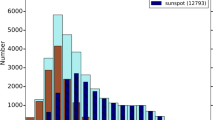Abstract
A comparative analysis of sunspot sizes in sunspot groups was performed. For this analysis, we used the database of characteristics of individual sunspots and pores according to observations at the Kislovodsk Mountain Astronomical Station (KMAS) and the photoheliographic data from the Debrecen Heliographical Observatory, Hungary (DPD). We found agreement in the full area index for sunspot groups. However, in the DPD data for 1974–2018, the number of groups is ~50% higher than that for the KMAS data. The difference is that there are a large number of groups in the DPD data with an area of 1 mdp or less. We also found a significant difference in the properties of spots and pores of different types within the group. A significant difference in the distribution pattern of the sunspot area, which is the largest in the group Smax and other spots Snomax, was detected. There are two local maxima, \({\text{S}}_{{{\text{spt}}}}^{1}\) ~ 8–10 mdp and \({\text{S}}_{{{\text{spt}}}}^{2}\) ~ 130–180 mdp, in the area distribution of the largest sunspot Smax in the group. The first maximum is associated with the existence of pores and transition spots in which the penumbra is at the formation stage. The second maximum Smax in the distribution is associated with the existence of regular spots. For the remaining spots Snomax in the group, the area distribution function monotonically decreases with increasing area.




Similar content being viewed by others
REFERENCES
Bumba, V. and Howard, R., The development of sunspot groups and the supergranular pattern, Proc. Sunspot Conf., 1964, vol. 220.
Dmitrieva, M.G., Kopecký, M., and Kuklin, G.V., The supergranular pattern and the stable stages of sunspot groups, Structure and Development of Solar Active Regions, Kiepenheuer, K.O., Ed., Budapest: International Astronomical Union, 1968, vol. 35, pp. 174–177.
Foukal, P., An explanation of the differences between the sunspot area scales of the Royal Greenwich and Mt. Wilson observatories, and the SOON program, Sol. Phys., 2014, pp. 289, no. 5, pp. 1517–1529.
Gyori, L., Automation of tracking various sunspot group entities and demonstrating its usage on the flaring NOAA AR 11429, Sol. Phys., 2015, vol. 290, pp. 1627–1639.
Gyori, L., Baranyi, T., and Ludmány, A., Photospheric data programs at the Debrecen Observatory, The Physics of Sun and Star Spots, Proceedings of the International Astronomical Union Symposium no. 273, IAU, 2011, pp. 403–407.
Gyori, L., Ludmány, A., and Baranyi, T., Comparative analysis of Debrecen sunspot catalogues, Mon. Not. R. Astron. Soc., 2017, vol. 465, pp. 1259–1273.
Kuklin, G.V., On two populations of sunspot groups, Bull. Astron. Inst. Czech., 1980, vol. 31, no. 4, pp. 224–232.
Muñoz-Jaramillo, A., Senkpeil, R.R., Windmueller, J.C., et al., Small-scale and global dynamos and the area and flux distributions of active regions, sunspot groups, and sunspots: A multi-database study, Astrophys. J., 2015a, vol. 800, no. 1, id 48.
Muñoz-Jaramillo, A., Senkpeil, R.R., Longcope, D.W., et al., The minimum of solar cycle 23: As deep as it could be?, Astrophys. J., 2015b, vol. 804, no. 1, id 68.
Nagovitsyn, Y.A. and Pevtsov, A.A., On the presence of two populations of sunspots, Astrophys. J., 2016, vol. 833, no. 1, id 94.
Nagovitsyn, Y.A., Pevtsov, A.A., and Livingston, W.C., On a possible explanation of the long-term decrease in sunspot field strength, Astrophys. J. Lett., 2012, vol. 758, no. 1, id L20.
Tlatov, A.G., Vasil’eva, V.V., Makarova, V.V., and Otkidychev, P.A., Applying an automatic image-processing method to synoptic observations, Sol. Phys., 2014, vol. 289, no. 4, pp. 1403–1412.
Vitinsky, Yu.I., Kopecky, M., and Kuklin, G.V., Statistika pyatnoobrazovatel’noi deyatel’nosti Solntsa (Statistics of Sunspot Formation Activity), Moscow: Nauka, 1986.
Funding
This work was partially supported by the Russian Foundation for Basic Research, project no. 18-02-00098, and the Russian Scientific Foundation, project no. 15-12-20001.
Author information
Authors and Affiliations
Corresponding author
Ethics declarations
The authors declare no conflict of interest.
Additional information
Translated by E. Seifina
Rights and permissions
About this article
Cite this article
Tlatov, A.G., Skorbezh, N.N., Sapeshko, V.I. et al. Comparative Analysis of the Catalog of Individual Sunspots Based on Data from Kislovodsk Mountain Astronomical Station. Geomagn. Aeron. 59, 793–798 (2019). https://doi.org/10.1134/S0016793219070235
Received:
Revised:
Accepted:
Published:
Issue Date:
DOI: https://doi.org/10.1134/S0016793219070235




